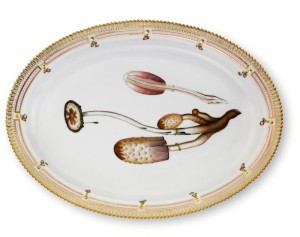The Flora Danica service is world famous for its delicately painted flowers. However the comprehensive publication Flora Danica also contains a large collection of indigenous fungi. Last year Flora Danica painters of Royal Copenhagen have begun for the first time since 1790 to paint an individual collection of fungi motifs on the gilt-edged porcelain.
On the shiny white porcelain the magnificent common puffball stands proudly in shades of café au lait. It is so true to nature that you can almost smell the mossy forest floor and feel the thrill of finding mushrooms in the countryside. It is the botanical accuracy and precise reproduction of the flora that has made Flora Danica porcelain world famous. The porcelain painter’s personal enthusiasm and artistic skill give the motif depth and fine nuances so that it seems to rise expressively in three dimensions from the surface of the plate.
Startling
The 26 motifs depicting fungi now being introduced into the Flora Danica range might be slightly startling to romantic spirits. The colours used for the series of fungi were determined autocratically by nature, with browns and greys, white, fiery reds and a few purple shades among the golden hues of the forest floor. The result is striking, uncompromising and alluring.
First launch in recent times
The history of Flora Danica goes back to 1790, when King Christian VII ordered the first Flora Danica service from the Royal Danish Porcelain Manufactory. The service was intended as a diplomatic gift to the empress Catherine II of Russia, and was designed to symbolise the most outstanding in Danish artistry and craftsmanship. The motifs for the service were taken from the comprehensive publication entitled Flora Danica, in which plants from the entire Kingdom of Denmark were illustrated according the principles of the Swedish naturalist Carl von Linné. In book form the work includes more than 3,000 hand-coloured copperplates of flowers, trees, aquatic plants and fungi. The publication not only depicts the various categories that grow in the Kingdom of Danmark, but also in Norway. The fjord country belonged at that time to Danmark.
More demanding
The actual process of painting the fungi takes longer and is more demanding than the other Flora Danica motifs, because each motif or group of fungi is repeated in a smaller size around the edge of the plate or dish. In other words, each fungus is painted seven times altogether on each item – meticulously correct every time, down to the last detail of the anatomy of the fungus.
Twelve
This fungi collection of Flora Danica is available in a set of twelve dinner plates with different motifs, twelve deep plates with twelve more motifs, and two oval dishes. Altogether twenty-six fungi have been selected. The items can also be bought individually. The plates are available either with or without the exclusive lace edge. Is there anything more exciting than serving chanterelle soup or stuffed mushrooms in plates of the Fungi series?
For more information visit www.royalcopenhagen.dk
For retailers in The Netherlands contact: C FORMS, tel. +31 (0) 162 51 11 56
(May 3, 2007, Leslie Leijenhorst)


